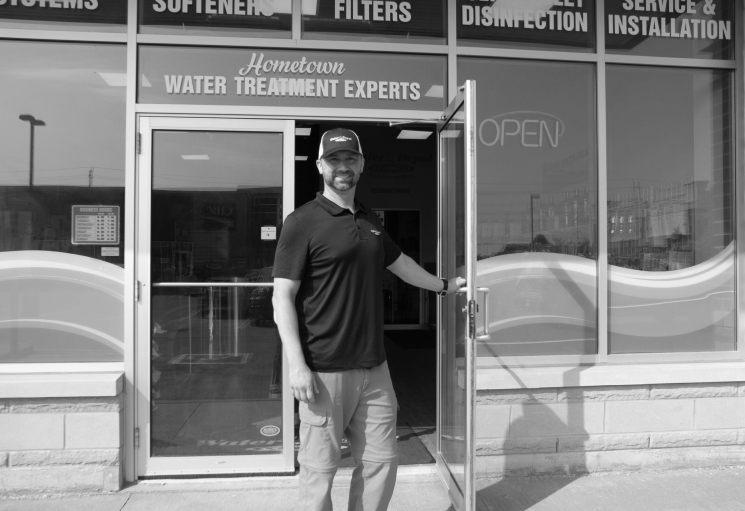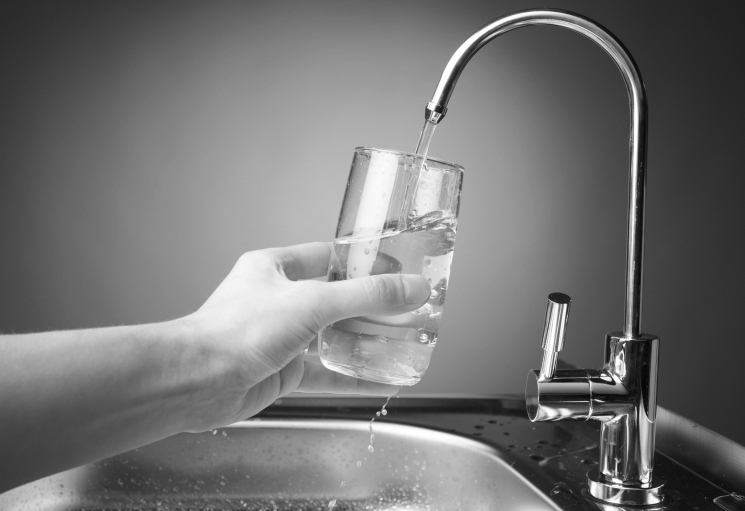
Have you ever gone to get a glass of water from your tap and wondered why the water seems a bit cloudy? Or maybe you’ve noticed some staining or scale build-up appearing on your bathroom fixtures? Do you have a cottage or rural property and wonder if the water is safe for drinking? A residential water treatment system can solve all these problems, and more.
The 4 main purposes of residential water treatment are:
- To reduce hardness, turbidity, colours, and odours in water
- To reduce chemicals used in municipal water treatment
- To reduce the impurities in water
- To create potable water that is safe for drinking
The type of problem you are trying to solve, the chemistry of the water you are treating, and how much water your family uses will determine which pieces are required in your water treatment system.
Reducing Hardness
Water Softeners are the most common form of water treatment. Hard water causes scale to build up on fixtures, appliances, and pipes. The hardness minerals in water also cause your hair, skin, and nails to dry out.
A water softener uses an ion exchange process to trap and reduce minerals that cause hard water, leaving you with soft, clear water.
Reducing Turbidity
Turbidity occurs when tiny particles of matter remain in your water, causing it to appear cloudy. Known as sediment, these particles can include silt, sand, organic and inorganic matter, algae, and other microscopic organisms.
Reducing turbidity can be accomplished with a pre-filter made to trap and hold the particles of matter. Not only is a pre-filter going to reduce the cloudiness of the water coming out of your tap, but it also plays an important role in larger water treatment systems, as the sediment can reduce the effectiveness of water softeners and Ultraviolet systems, to name a few.
Reducing Tastes, Colours, and Odours
A common complaint, especially with rural water, is brownish-coloured water that leaves rust stains on sinks and fixtures, a metallic taste and odour. The cause of which is iron-laden water. In addition to the unpleasant look and taste iron has on your water, it can build up inside your pipes and fixtures causing clogs, loss of pressure and flow. Also, certain bacteria feed off the iron and create a smelly slime inside toilet tanks and water heaters.
Iron Filters are created to reduce red and clear iron, as well as Hydrogen Sulphide, resulting in clear, odour-free water that won’t stain your fixtures.
Reducing Chemicals
Most municipal water has been through a water treatment process that involves using Chlorine and Chloramines for disinfection purposes. Both these chemicals play an important role in protecting your water from contamination and at the regulated levels may not be harmful. However, once these chemicals are introduced to the water stream, they can react with the organic material naturally found in water, such as decaying leaves or other vegetation found in the environment. This can produce a chemical reaction that creates a group of disinfection by-products. These by-products are known as Trihalomethanes (THMs), which can include Chloroform, Bromoform and several other chemicals.
A Water Depot Chloramax Whole Home System is designed specifically for Municipal applications to reduce Chlorine, Chloramines and disinfection by-products including THMs, pesticides, herbicides, as well as reducing taste and odour.
Reducing Impurities
Many times, your water may seem clean and clear but could contain contaminants and impurities that could be reduced to improve the purity and taste of your drinking water, including:
- Lead
- Chloride
- Copper
- Chromium
- Arsenic
- Fluoride
- Radium
- Sulphate
- Calcium
- Magnesium
- Potassium
- Nitrate
- Phosphorous
A Reverse Osmosis system uses a series of filters and a reverse osmosis membrane to improve taste and odour and remove or reduce many of the impurities listed above. Reverse Osmosis systems can be installed at Point-of-Entry (POE) or Point-of-Use (POU). A POE system is installed where the water enters your home and will treat every drop of water in your home. More commonly, a POU system is installed under your kitchen sink, with a dedicated faucet, and is used to treat the water you use for drinking and cooking. A POU system can also be plumbed into your fridge.
Creating Potable Water
Rural water can quite often contain microorganisms and pathogens, such as e.coli and coliform, making it unsafe for drinking.
An Ultraviolet treatment system offers effective disinfection against water-borne pathogens. As water passes through the system, a high-intensity UV light inactivates these microorganisms, creating clean drinking water.
Water Testing
When considering whether you require a residential water treatment system, it is essential to start with a water test. Water chemistry differs in every home or cottage and a water test will determine your home’s unique water chemistry and your family’s water demand. The results will provide a water treatment expert with the data required to determine which pieces of equipment should be a part of your water treatment solution.
Water Depot
Water Depot offers complimentary in-home or in-store water tests. During the test, your raw water will be examined for a variety of factors, and you will be asked a series of questions about your family’s water usage.
Did you find the information in this article useful? Water Depot are your local water treatment experts, carrying a large selection of water treatment products. Get started today with your free water test.






